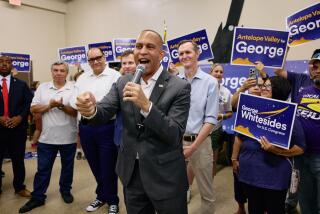California’s shifting axis
It’s not the Civil War, of course. There’s no Andersonville or Quantrill’s Raiders. But from the time that L.A.-spawned Jesse Unruh captured the Assembly speakership in 1961 and transformed it from an office of ceremony into an office of power, a north-south axis has defined the Legislature. The majority leaders of both the Assembly and Senate have largely come from San Francisco or Los Angeles -- or hard by.
The Bay Area contingent has included Willie Brown, John Burton and Don Perata, and the L.A.-area team has boasted the likes of Dave Roberti, Antonio Villaraigosa and Fabian Nunez. Even into the mid-1990s, as term limits kicked in and forced shorter terms for leaders and the rank and file, the last real Republican speaker of the Assembly, Curt Pringle, was from Anaheim.
But the Legislature’s longtime north-south axis is tilting toward an east-west axis, a reflection in part of the swelling population, economic might and political clout of California’s interior. For the first time in more than a decade, one of the majority leaders hails from the interior.
He is Darrell Steinberg of Sacramento, the newly designated Senate president pro tem and a farm-belt liberal. The majority leader position is arguably the most powerful in the Legislature, including the Assembly speakership, because senators can serve two years longer in the Capitol.
In the past, minority GOP leaders have often come from the state’s interior, which tends to be more Republican and conservative. Jim Brulte, a former GOP leader in both houses, was from Rancho Cucamonga. Fresno has served as a Republican leadership hatchery for decades. The late Ken Maddy, an urbane and canny politico who led Republicans in both houses and ran for governor in 1978, came from there. So did former Assemblyman Charles Poochigian, the point man on the overhaul of the state’s workers’ compensation insurance system. The two current GOP leaders -- Mike Villines in the Assembly and David Cogdill in the Senate -- have close links to Fresno. Villines is from there, and Cogdill keeps a district office in the city.
But traditionally, those Republicans served as minority leaders in houses run by Los Angeles or Bay Area Democrats. Not any more.
In selecting their leaders, the party caucuses in the Assembly and Senate don’t focus on issues or geography. Instead, lawmakers want to know what prospective leaders can do for them -- support a cause, raise money or provide protection if they screw up. In the end, it comes down to personality and promises, not geography. But after the new leaders are selected, geography inevitably comes up.
This shift in legislative leadership toward inland California portends policy changes. There is no crystal ball, of course. But there are some signs that issues important to the region are moving to the Legislature’s front burner.
First is water, the biggest of a long list of big issues facing the state. In the interior, there has been a push to build dams and reservoirs, even a peripheral canal, a proposal defeated by voters in 1982, to ensure future water supplies.
A second fundamental concern in inland California is air quality. The San Joaquin Valley, plagued by soaring population growth and long commutes, shares with the Los Angeles area the distinction of having the worst air quality in the nation.
A third issue is land use, specifically the conversion of farmland and open spaces into residential and commercial development, which has transformed the nature of the Central Valley.
All areas of the state have these concerns, to be sure, but in the central interior, the three are overarching. For instance, inland Californians didn’t create the region’s air-quality woes -- they just breathe the air that blows inland from the clogged population centers on the coast. People unable to afford coastal housing have moved inland, where farmland has been increasingly turned into suburbs. And more people means more demand for water.
The bottom line is that inland residents believe that they pay inordinately for the problems of the coast that drive people toward the interior.
Steinberg, an environmentalist and preservationist, favors open space over development. Cogdill and Villines, both of whom come from the richest farmland in the world, favor farms over rampant development. All see water as their lifeblood. As the state wrestles with the question of whether to build dams or a version of the peripheral canal to move more water to the south or expand groundwater storage, the three will play pivotal roles.
Water and the other issues will be at the top of the new leaders’ agendas because they’ve said as much. “I view my new position not as a personal accomplishment but as a historic opportunity for the Central Valley,” Villines wrote in an Op-Ed article published in his hometown paper, the Fresno Bee. He listed his priorities: water storage (“water storage” in Capitolspeak means dams), crop yields and road construction. These are the bread-and-butter issues of the Central Valley -- indeed, most of rural California -- and Villines gives voice to them.
Cogdill, meanwhile, carried Gov. Arnold Schwarzenegger’s unsuccessful plan to build dams and reservoirs, as well as fix the Sacramento-San Joaquin River Delta’s environmental problems, to ensure reliable water supplies in the future. The bill died earlier this year in the Senate.
But a new water package, based on the findings of the governor’s water advisory group, is likely to emerge in the form of a bond measure, and Cogdill is all but certain to be at the center of it.
Steinberg is no dam builder. But he is a canny negotiator with a reputation for bringing rival interests together.
His accession to Perata’s job is particularly galling for the Bay Area. For 34 years, someone from the San Francisco area has run at least one house of the Legislature, sometimes both. “San Francisco is used to having the speakership, the pro tem or the Appropriations Committee chairs. To the extent there is any loser here, it’s probably the Bay Area,” Brulte told me when I asked him about the change in legislative leadership.
The question is whether Steinberg, and the two GOP minority leaders, can make inland California a winner in the legislative policy wars.
More to Read
Get the L.A. Times Politics newsletter
Deeply reported insights into legislation, politics and policy from Sacramento, Washington and beyond. In your inbox three times per week.
You may occasionally receive promotional content from the Los Angeles Times.










